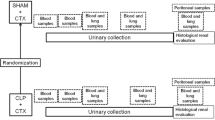Summary
We have compared in two separate studies the kinetics of ceftriaxone and cefotaxime in 8 cirrhotic patients with ascites and 8 control subjects after a single 20 min intravenous infusion of 1 g of each drug.
The apparent volumes of distribution (Vz) were found to be significantly higher in cirrhotics than in control subjects (0.87, versus 0.49, l·kg−1, for cefotaxime and 0.23 versus 0.13 for ceftriaxone).
The elimination kinetics of ceftriaxone were similar in the two groups. In contrast, the total and non-renal clearances of cefotaxime were reduced in cirrhotic patients.
The two drugs rapidly entered the ascitic fluid. Peritoneal concentrations of ceftriaxone were higher than 7 µg·ml−1 from the second hour after the infusion and were 8.9 µg·ml−1 at 24 h. Peritoneal concentrations of cefotaxime were higher than 4 µg·ml−1 from 0.5 to 8 h after the infusion.
Similar content being viewed by others
References
Clumeck N, Estenne M, Vanhoof R, Reding R, Cornil A (1979) Septicémie et péritonite “spontanée” chez le cirrhotique. Presse Med 8: 2655–2658
Hoefs JC, Canawati HN, Sapico FL, Hopkins RR, Weiner J, Montgomerie JZ (1982) Spontaneous bacterial peritonitis. Hepatology 2: 399–407
Caralis PV, Sprung CL, Schiff ER (1984) Secondary bacterial peritonitis in cirrhotic patients with ascites. South Med J 77: 579–583
Carmine AA, Brogden RN, Heel RC, Speight TM, Avery GS (1983) Cefotaxime: A review of its activity, pharmacological properties and therapeutic use. Drugs 25: 223–289
Richards DM, Heel RC, Brogden RN, Speight TM, Avery GS (1984) Ceftriaxone. A review of its antibacterial activity, pharmacological properties and therapeutic use. Drugs 27: 469–527
Trautmann KH, Haefelfinger P (1981) Determination of Ro 13-9904 in plasma, urine and bile by means of ion-pair reversed phase chromatography. J High Resol Chromatogr Commun 4: 54–59
Hary L, Andrejak M (1987) Dosage du cefotaxime et du désacetylcéfotaxime sériques par chromatographie liquide haute performance avec appariement d'ions. J Chromatogr 419: 396–400
Hayton WL, Stoeckel K (1986) Age-associated changes in ceftriaxone pharmacokinetics. Clin Pharmacokinet 11: 76–86
Stoeckel K, Tuerk H, McNamara PJ, Trueb V (1984) Single-dose ceftriaxone kinetics in liver insufficiency. Clin Pharmacol Ther 36: 500–509
Arvidsson A, Alvan G, Anvelin B, Borga O, Nord CE (1982) Ceftriaxone renal and biliary excretion and effect on colon microflora. J Antimicrob Chemother 10: 207–215
Stoeckel K, McNamara PJ, Brandt R, Plozza-Nottebrock H, Ziegler WH (1981) Effects of concentration-dependent plasma protein binding on ceftriaxone kinetics. Clin Pharmacol Ther 29: 650–657
Höffken G, Lode H, Koeppe P, Ruhnke M, Bornen K (1984) Pharmacokinetics of cefotaxime and desacetyl-cefotaxime in cirrhosis of the liver. Chemotherapy 30: 7–17
Benoni G, Arosio E, Raimondi MG, Pancera P, Lechi A, Velo P (1985) Pharmacokinetics of ceftazidime and ceftriaxone and taheir penetration into the ascitic fluid. J Antimicrob Chemother 16: 267–273
Regamey C (1985) Pharmacokinetics of ceftriaxone and its relation to concentrations in extravascular compartments. Comparison with cefotaxime. Chemotherapy 31: 85–94
Felisart J, Rimola H, Arnozo V, Perez-Ayuso RM, Quintero E, Gines P, Rodes J (1985) Cefotaxime is more effective than is ampicillin-tobramycin in cirrhotis with severe infections. Hepatology 5: 457–462
Cabrera J, Arroyo V, Ballesta A, Rimola A, Gual J, Elena M, Rodes J (1982) Aminoglycoside nephrotoxicity in cirrhosis. Value of urinary β-microglobulin to discreminate functional renal failure from acute tubular domage. Gastroenterology 82: 97–102
Moore RD, Smith CR, Lipsky JJ, Mellits ED, Lietman PS (1984) Risk factors for nephrotoxicity in patients treated with aminoglycosides. Ann Intern Med 100: 352–357
Cardey J, Silvain C, Bouquet S, Breux JP, Becq-Giraudon B, Fourtillan JP, Beauchant M (1987) Oral pharmacokinetics and ascitic fluid penetration of pefloxacin in cirrhosis. Eur J Clin Pharmacol 33: 469–472
Author information
Authors and Affiliations
Rights and permissions
About this article
Cite this article
Hary, L., Andrejak, M., Leleu, S. et al. The pharmacokinetics of ceftriaxone and cefotaxime in cirrhotic patients with ascites. Eur J Clin Pharmacol 36, 613–616 (1989). https://doi.org/10.1007/BF00637745
Received:
Accepted:
Issue Date:
DOI: https://doi.org/10.1007/BF00637745




